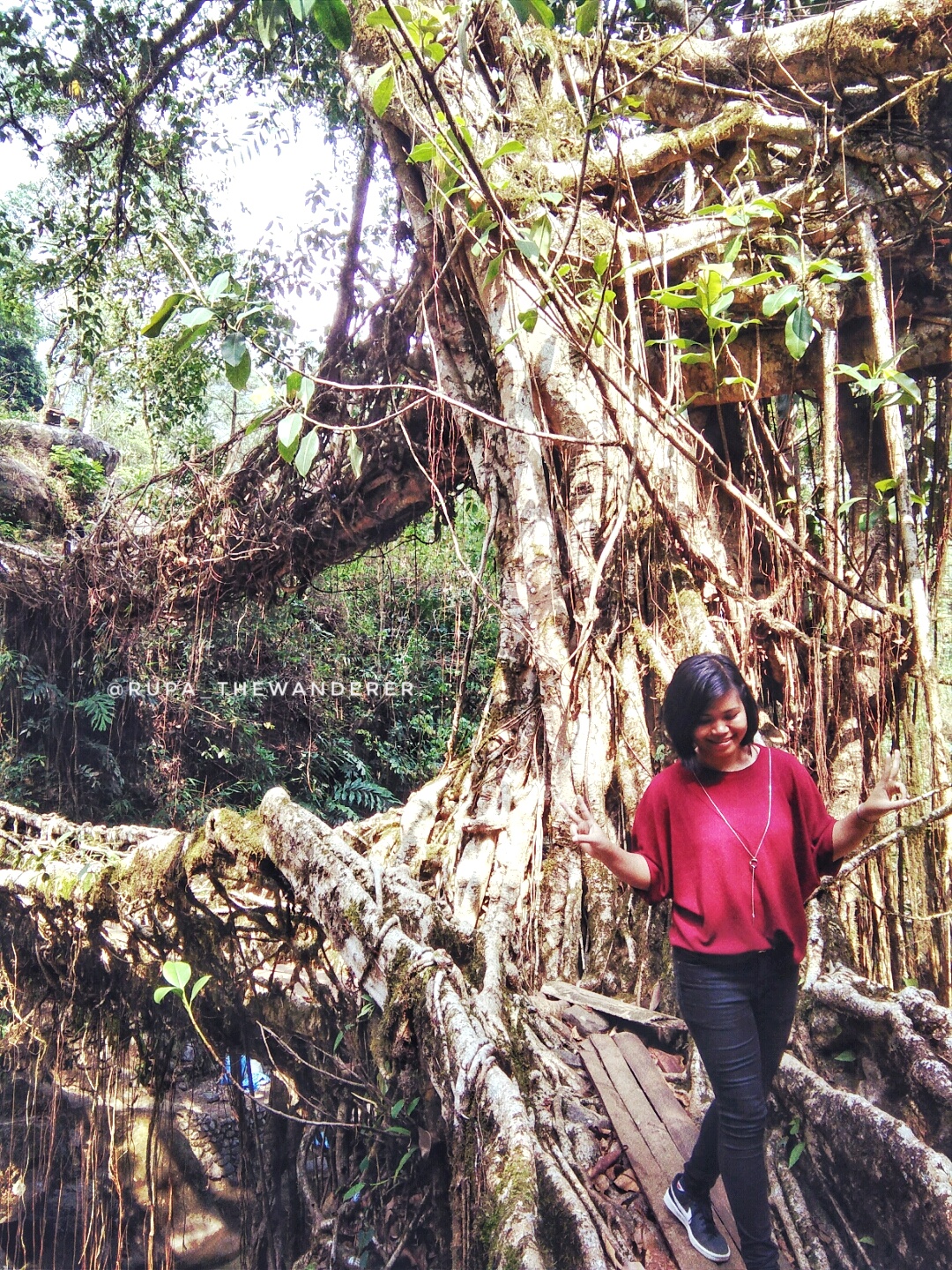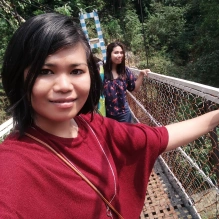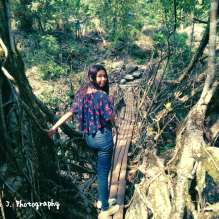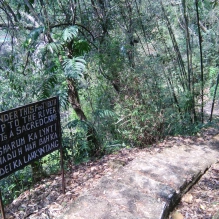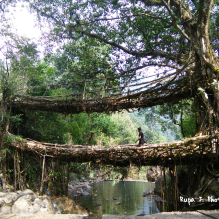
One of my bucket list journeys, was spring, not a season for many waterfalls in Meghalaya, but I am happy that I got a plan and time to offbeat the season. This is not my recent travel, this was done during spring break. Now I have time to write down all my travel diaries and share them with you all.
I always wondered about having an adventure in life before I grow old I mean too old then the plan for trekking came across my mind then thought about the double-decker living root bridge unknown about the place because the name itself is so fascinating to explore.
“The best view comes after the hardest climb.”
Okay, before moving towards my journey, let’s know a bit about the Living Root Bridge.
A living root bridge is formed by guiding the young roots of the tree across a stream or river, and then allowing the roots to grow and strengthen over time until they can hold the weight of a human being. The young roots are sometimes tied or twisted together, and are often encouraged to combine over scaffolds made from wood or bamboo, the roots are wrapped around the outside of the perishable material. As they are made from living, growing, organisms, the useful lifespan of any given living root bridge is variable. It is thought that, under ideal conditions, a root bridge can last for many hundreds of years. As long as the tree from which it is formed remains healthy, the bridge will naturally self-renew and self-strengthen as its component roots grow thicker.
While there are many single-root bridges in the area, this is the only one that has two levels. Local Khasi tribe members created the second level after an unprecedented wet monsoon season caused water to reach the first level. The beauty and cleanliness of the village are also outstanding. The residents have high regard for the environment. While the root bridge is undoubtedly remarkable, its surroundings feel like a place where magic happens.
How do I get there?
- Distance From Shillong: Two and a half hours. It can be comfortably done on a day trip from Shillong to Tyrna and costs about 2,000-3,000 rupees depending on the type of car. A reliable taxi can be hired easily who’s based in Shillong and knows the area.
“For hiking/trekking is one of those things that you can only do when you have the determination in you.”
About the trekking:
The trek to the double-decker root bridge starts at Tyrna village. The treks to the root bridges vary in duration and level of difficulty. Visiting the double-decker root bridge is not easy. The trek there is long and tiring. You will come across rivers with clear water with many rocks and hanging bridges made with iron in between the trekking. The trekking is done for around 3.5 kilometers across the steep stairs, approximately 3,000 stairs cut from the rocks. It’s worth it, though, for an out-of-this-world experience that’s guaranteed to be a highlight on the list of your travels.
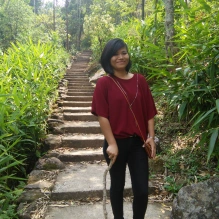
You’re capable of it and how difficult it will be. The reality is that you don’t have to be super fit. However, if you have any joint or mobility issues, or are not in decent physical condition or breathing issues– don’t do it. The trek is very steep in parts and will put a lot of strain on your knees and calf muscles. I still remember the choice I made to go trekking and remember how my legs were trembling while going down the very steep stairs. (sounds funny right…).
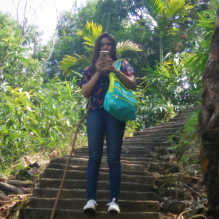
I don’t consider myself to be fit. The trek took me and my sister one and a half hours each way, taking a rest in between like around 5–10 minutes after completing each part. This was walking at a leisurely pace there and a steady pace on the way back. I spent an hour relaxing at the double-decker root bridge. So, all up, I completed the trek in four hours. My muscles hurt a lot for a few days afterward.
Caution: We won’t realize the strain or pain on the same day. So, take a hot shower after returning to avoid or reduce muscle strain and pain.
Coming across before reaching the double-decker living root bridge
There are three parts to the trek. The steepest and most challenging part is the first part, down the hill to Nongthymmai village the longest root bridge, Ritymmen, is located.
Nongthymmai is a surprisingly attractive village of beekeepers with neat cement paths, well-groomed flower gardens, and a blue and white painted Church. From there, it takes at least another hour to reach the double-decker root bridge.
The remaining two parts of the trek, which involve crossing narrow steel suspension bridges over raging rivers, are much flatter and less taxing. However, this, as well as the steep descent, may make the trek challenging for anyone who’s afraid of heights or has a reeling sensation.
Just in between the trekking, I started doubting whether I’ll ever get there, after tackling yet another ascending staircase you’ll be greeted with a sign announcing Nongriat village. Drag yourself up the final set of stairs, look down, and there it will be, like something from a fairy tale-the double-decker root bridge. Then, it’s a victory.
What you should Wear?
However, it’s preferable to wear as little light as possible (Trek pants/shorts and a T-shirt). Due to the strenuous nature of the trek, you’ll get hot very quickly. Your clothes will become saturated with sweat, and it’s much more comfortable to let your skin breathe. Regarding footwear, choose comfortable shoes that have a good grip.
What to take handy?
- You might be concerned about the weather, so I suggest it’s a good idea to bring: an umbrella or a raincoat.
- Pack some food and water, as you’ll only find a couple of shacks selling packaged drinking water and snacks along the way from Tyrna to Nongriat village (in fact, the price may be charged extra). You’ll be able to get basic Indian vegetarian meals at Nongriat.
- Wearing a cap and sunscreen is recommended to protect the skin.
- Mosquitoes are present in the evening, so you might want to consider mosquito repellent cream as well.
- It’s possible to go swimming in the natural pools at the double-decker bridge, so bring appropriate swimwear if you want to do this (it’s refreshing to bathe in the chill water directly from the waterfall, and change rooms are provided).
Do be aware that everything you take adds to the weight, though, and you’ll feel it when hiking back up the hill. And last but not the least, don’t ever forget to take the strong stick with you to maintain the grief while trekking through the steep stairs (people out there may try to sell you the stick, but please don’t be foolish to buy it…better find some strong branches around since you are surrounded by the nature).
Other Things to Note
Entry and camera fees are payable at the double-decker root bridge. The cost is 10 rupees for adults, 5 rupees for children, and 20 rupees for a camera. The local people here are very conscious of their environment and maintaining its cleanliness. Indian-style toilets are available at the double-decker bridge, and there’s a fine of 500 rupees for anyone caught relieving themselves in the forest or throwing rubbish. Aim to be back early at Tyrna by 5 p.m. at the latest, as it starts getting dark early there. It’s not necessary to take a guide, although many people do, as the pathway is signposted.
Hope you all enjoy reading, happy sharing my experience. Do comment and write if I can improve my writing, do like and share….till then see yea…keep reading.

